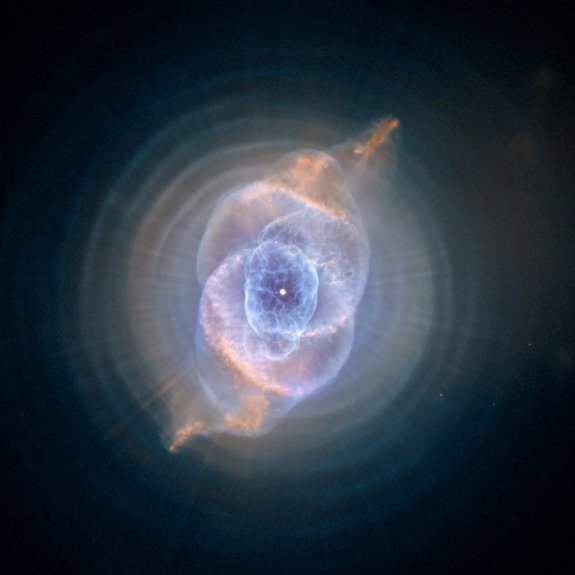by neufer » Sun May 09, 2010 3:42 pm
Alex wrote:The APOD image of May 9, 2010, showing the immense halo around the Cat's Eye Nebula reveals a intriguing detail. There are concentric rings or ripples around the Eye. Maybe the rings are merely an artifact of image precessing to enhance the very faint halo. Or do they reveal a natural feature of the nebula that is already known and analyzed? I’ve attached my own enhancement of a part of the APOD image to illustrate the ‘rings around the cat’s eye’. Alex
http://www.daviddarling.info/encyclopedia/C/Cats_Eye_Nebula.html wrote:

Cat's Eye Nebula, 2004 Hubble image
Hubble Space Telescope image taken in 2004
<<Further astonishing detail of the Cat's Eye emerged in 2004 following the release of a new, more detailed Hubble Space Telescope image taken with Advanced Camera for Surveys (ACS). This image reveals a pattern of at least 11 concentric rings, or shells, around the inner portion of the nebula. Each ring is actually the edge of a spherical bubble seen projected onto the sky. Observations suggest the star ejected its mass in a series of pulses at 1,500-year intervals. These convulsions created dust shells, each of which contain as much mass as all of the planets in our Solar System combined.
Until recently, it was thought that such shells around planetary nebulae were rare. However, Romano Corradi (Isaac Newton Group of Telescopes, Spain) and collaborators, in a paper published in the European Journal Astronomy and Astrophysics in April 2004, argued that the formation of these rings is likely to be the rule rather than the exception.
The bull's-eye patterns seen around planetary nebulae came as a surprise to astronomers because they had no expectation of episodes of mass loss at the end of stellar lives that repeat every 1,500 years. Several explanations have been proposed, including cycles of magnetic activity somewhat similar to our own Sun's sunspot cycle, the action of companion stars orbiting around the dying star, and stellar pulsations. Another school of thought is that the material is ejected smoothly from the star, and the rings are created later on due to formation of waves in the outflowing material. Further observations and theoretical studies will be needed to decide between these and other possible explanations.
About 1,000 years ago the pattern of mass loss suddenly changed, and the Cat's Eye Nebula started forming inside the dusty shells. It has been expanding ever since, as discernible in comparing Hubble images taken in 1994, 1997, 2000, and 2002. The puzzle is what caused this dramatic change. Many aspects of the process that leads a star to lose its gaseous envelope are still poorly known, and the study of planetary nebulae is one of the few ways to recover information about these last few thousand years in the life of a Sun-like star. >>
[quote="Alex"]The APOD image of May 9, 2010, showing the immense halo around the Cat's Eye Nebula reveals a intriguing detail. There are concentric rings or ripples around the Eye. Maybe the rings are merely an artifact of image precessing to enhance the very faint halo. Or do they reveal a natural feature of the nebula that is already known and analyzed? I’ve attached my own enhancement of a part of the APOD image to illustrate the ‘rings around the cat’s eye’. Alex[/quote]
[quote=" http://www.daviddarling.info/encyclopedia/C/Cats_Eye_Nebula.html"]
[img]http://www.esa.int/images/_catseye_xl.jpg[/img]
Cat's Eye Nebula, 2004 Hubble image
Hubble Space Telescope image taken in 2004
<<Further astonishing detail of the Cat's Eye emerged in 2004 following the release of a new, more detailed Hubble Space Telescope image taken with Advanced Camera for Surveys (ACS). This image reveals a pattern of at least 11 concentric rings, or shells, around the inner portion of the nebula. Each ring is actually the edge of a spherical bubble seen projected onto the sky. Observations suggest the star ejected its mass in a series of pulses at 1,500-year intervals. These convulsions created dust shells, each of which contain as much mass as all of the planets in our Solar System combined.
Until recently, it was thought that such shells around planetary nebulae were rare. However, Romano Corradi (Isaac Newton Group of Telescopes, Spain) and collaborators, in a paper published in the European Journal Astronomy and Astrophysics in April 2004, argued that the formation of these rings is likely to be the rule rather than the exception.
The bull's-eye patterns seen around planetary nebulae came as a surprise to astronomers because they had no expectation of episodes of mass loss at the end of stellar lives that repeat every 1,500 years. Several explanations have been proposed, including cycles of magnetic activity somewhat similar to our own Sun's sunspot cycle, the action of companion stars orbiting around the dying star, and stellar pulsations. Another school of thought is that the material is ejected smoothly from the star, and the rings are created later on due to formation of waves in the outflowing material. Further observations and theoretical studies will be needed to decide between these and other possible explanations.
About 1,000 years ago the pattern of mass loss suddenly changed, and the Cat's Eye Nebula started forming inside the dusty shells. It has been expanding ever since, as discernible in comparing Hubble images taken in 1994, 1997, 2000, and 2002. The puzzle is what caused this dramatic change. Many aspects of the process that leads a star to lose its gaseous envelope are still poorly known, and the study of planetary nebulae is one of the few ways to recover information about these last few thousand years in the life of a Sun-like star. >>[/quote]